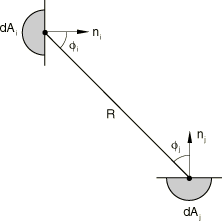View factor between elementary areas
The dimensionless view factor between two elementary areas, and , satisfies the relation
where is the distance between the two areas and are the angles between and the normals to the surfaces of the areas (Figure 2). The view factor also satisfies the reciprocity relation

When the areas and are small compared with the distance , we can compute view factors in an area-lumped fashion; so the integral Equation 1 would become
However, this expression is singular in , so it is not well behaved for general surfaces. Thus, we use
The limit of Equation 3 for large is Equation 2.
If the areas and are not small compared with the distance , but one of the areas is much larger than the other (say ), we can use the formula
where is the unit normal to the smaller area . The vector is normal to the triangle defined by the centroid of area and the edge of area , and has magnitude equal to the angle opposite to edge . See, for example, Hottel and Sarofim (1967).
For all other configurations Abaqus uses the method developed by Mitalas and Stephenson (1966), where Stokes theorem is used in Equation 1 and one of the contour integrals is solved analytically. The remaining contour integral is evaluated numerically,
where is the dot product between edge of area and edge of area . The angles , , and are the angles of the triangle defined by edge and the integration point . The scalars , , and are the lengths of the sides opposed to , , and , respectively. The height of the triangle perpendicular to side is . The integration point length is along the edge .


